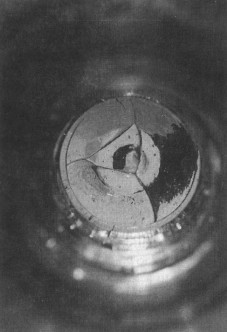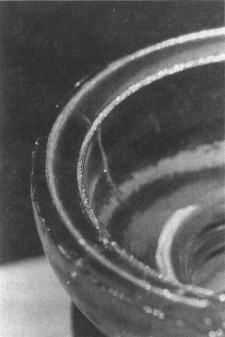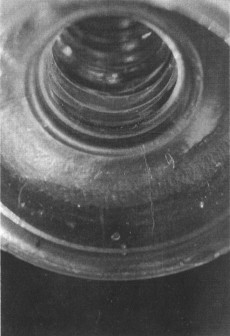CD 131.8, Who Are You?
by Timothy M. Baggett
Reprinted from "Crown Jewels of the Wire", April 1989, page 7
The hobby of insulator collecting is a most interesting and fascinating one.
Indeed we all enjoy the hobby and the excitement whenever a new and different
piece is added to our collections. However, we sometimes run into an insulator
that gives us a challenge in trying to identify its origins.
I purchased an insulator about 14 years ago at a country antique store and
got a good deal on it because it had a small chip on the base. It was unusual
due to the fact it had a 1" round flat spot on the top of the crown. It's
shape is somewhat similar to a CD 151, but it has no inner skirt.
I met Marion and Evelyn Milholland at the Nashville Flea Market one afternoon and showed it to Mr. Milholland. He told me that it was not in the book and
a new CD number would have to be assigned to it. It made me feel good to know I
had found something that was different. A few weeks later I got a postcard from
Mr. Milholland telling me the insulator would be listed as a CD 131.8. By this
time he had seen an other one just like it and would use it for the picture in
his book. Over the years, I have kept a lookout for one for sale in back issues
of CROWN JEWELS OF THE WIRE. None ever showed up for sale. So, I just kept an
eye on the price guides and wondered if "OPEN" would ever change and
have a price.
I have always wanted to go to a big insulator show, but never had the time to
go. Well, 1988's Eastern Regional was held just an hour drive away from my home
at the Nashville Flea Market. I have attended the Nashville Flea Market for many
years and in fact use to set up and sell at this show. Needless to say, the show
had come to town.
I loaded up everything I wanted to sell and trade and set out for the show. I
carried the CD 131.8 along to see if I could find out anything about it. All of
the dealers I showed it to were very interested in it. From what I gathered,
there have only been a few of these pieces found. Kevin Lawless, who deals in
much of the rare glass, seemed to feel that this insulator is a Pennycuick and
made of glass with a "Boston-look" about it.
J.G. Pennycuick was issued Patent #324,157 on Aug.11, 1885 for a method of forming screw threads on or in glass.
His improvement on the process was a means of leaving the thread forming plunger
in the glass while it was being annealed. The plunger would be coated with some
type of substance which would prevent the glass from adhering to the plunger. In
his specifications for use of his invention, it was suggested that the plunger he heated to a temperature fairly high and work with molten glass
that was at it's lowest workable temperature. This would offset the differences
of expansion and contraction of the plunger and the glass. His recommendation of
leaving the plunger in the glass differed from William Brookfield's Patent
#113,393 of April 4, 1871, in which the threading plunger was removed before
the glass was annealed. Pennycuick felt by having the plunger remain in the
glass, the threads would come out as intended and not he ruined by the annealing
process.
The threads of the 131.8 are nice and uniform. At the top of the pin hole is
a small "dimple" indicating where the plunger would have been pulled
out. In fact, there is a slight ridge around the pinhole at the base of the
threads. Also there is a narrow lip around the inside of the skirt.

There is no
indication of any type embossing on the outer surface. Although the surface is
not etched or eroded, it does have an "orange peel" effect to it. The
center wire groove has many "whittle marks." Mold lines run from the
outside base of the skirt up to the edge of the 1" flat spot on the crown.
The mold lines are fairly heavy.
I have checked the piece in all intensities of light trying to see if maybe
there is a faint embossing (like on the dome of many CD 145 Brookfields).
However, under close observation, no embossing is to be found.
Someday the answer will come as to the origin of this different piece. But,
until that time we will continue to say, "CD 131.8, Who Are You???"

CD 131.8 with heavy mold line and uniform pinhole threads |

Dimple at top of pin hole as seen
from top of insulator |

Narrow lip around inside of skirt at base |

Ridge around base of pinhole |
| 